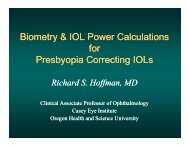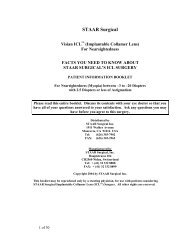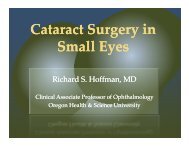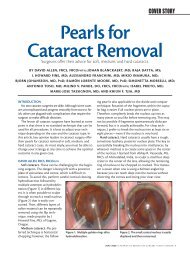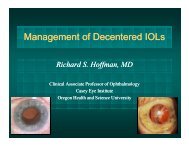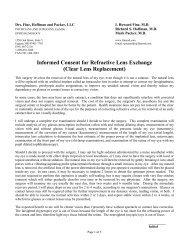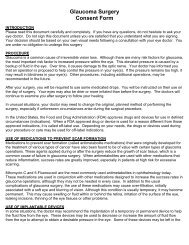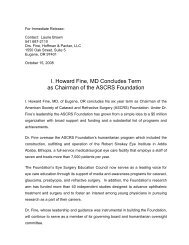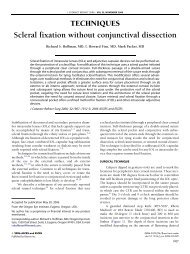Macular Degeneration - Drs. Fine, Hoffman and Packer
Macular Degeneration - Drs. Fine, Hoffman and Packer
Macular Degeneration - Drs. Fine, Hoffman and Packer
Create successful ePaper yourself
Turn your PDF publications into a flip-book with our unique Google optimized e-Paper software.
The typical first symptom (in either form) is blurring of vision. When the blurring is gradual, you may<br />
think you need new eyeglasses. But a new prescription is not likely to improve your vision because the<br />
problem is not with the optical parts of the eye.<br />
As time goes on, you may notice a hazy or dark zone in the center of objects you look at directly. Colors<br />
may begin to look different or lose richness. With wet AMD especially, straight lines, such as the edges of<br />
doorways, may start to look bent or crooked as vision becomes distorted <strong>and</strong> wavy. Symptoms may may<br />
be gradual or sudden (suddenness is more likely with wet AMD). When the loss of vision is in one eye<br />
only, you can't always tell how long it has existed, since it is "hidden" when both eyes are used together. It<br />
may only become apparent when the good eye is covered.<br />
Some people whose vision has been very poor (from AMD or from other causes) sometimes have visual<br />
hallucinations; they see things (objects or patterns) that are not really there. These phantom visions can last<br />
from a few seconds to a minute or so <strong>and</strong> then disappear. Such hallucinations are fairly common <strong>and</strong> they<br />
are not serious, but they are startling. Even so, people who have them generally don’t talk about them<br />
freely.<br />
Examination<br />
Your vision will be checked <strong>and</strong> you will have a refraction (test for glasses) along with a complete eye<br />
exam. Your pupils will be dilated (enlarged) with eyedrops so that the insides of your eyes can be evaluated<br />
with an ophthalmoscope. A special type of contact lens may be used for examining both retinas <strong>and</strong><br />
maculas under the high magnification of a slit lamp microscope.<br />
Photographs may be taken of the retina, to determine the extent of the problem <strong>and</strong> evaluate its progression.<br />
You may also have a retinal "angiogram," retinal photographs that help identify the position <strong>and</strong> extent of<br />
any abnormal blood vessels or leakages. For this test, called fluorescein angiography (FA), an orangecolored<br />
dye (fluorescein) is injected into a vein in your arm <strong>and</strong> then a series of photographs is taken as the<br />
dye travels through the eye's blood vessels. If more information is needed, a dye called indocyanine green<br />
(ICG) may be used to make another type of angiogram. Angiograms provide important guidance for<br />
treatment.<br />
Treatment<br />
So far, there are no medications that have proven to be effective. But wet AMD - in the early stages only -<br />
can sometimes benefit from treatment with a surgical laser, to seal the leaks or destroy the abnormal blood<br />
vessels under the macula. (The laser cannot help the dry type of AMD, or even most stages of the wet<br />
type.) The goal of laser treatment is to prevent further leadage <strong>and</strong> stabilize vision. Only occasionally does<br />
vision improve. Please don't expect miracles; the laser treatment may not help at all <strong>and</strong> vision may even<br />
get worse.<br />
Laser surgery is never undertaken lightly. No matter how accurately performed, it involves some risk to<br />
vision because the laser can destroy normal neighboring tissue along with abnormal tissue. So the<br />
procedure will be recommended only if the risk to your vision is small <strong>and</strong> there is a reasonable chance for<br />
success - that means that the degeneration is not too extensive, too advanced, or too near the center of the<br />
macula.<br />
Research<br />
Major clinical research is ongoing at many centers. New treatment <strong>and</strong> prevention methods are constantly<br />
being sought. Certain antioxidants, vitamins, <strong>and</strong> minerals are being studied as a way to slow the<br />
degeneration. Scientific evidence for their effectiveness is still inconclusive; some studies show beneficial<br />
results, others don't. (Until there are answers, you may decide to take a regular vitamin-mineral supplement<br />
for whatever help it might offer.) Several national studies are evaluating the effect of radiation therapy,<br />
especially low-dose X-rays to the eye, to treat the abnormal subretinal blood vessels. Other studies are



